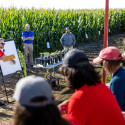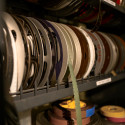Advances
Advances gives a glimpse of the many significant research projects at the university. Tell us about your discoveries. E-mail: wisweek@news.wisc.edu.
Laser test casts green glow
The pale, ghostly green pulse of light sometimes seen above Madison is not an omen that aliens are landing. Rather, it is a NASA laser being tested on the Ice, Cloud and Land Elevation Satellite.
The test uses calibrated instruments developed by the UW–Madison’s Lidar group and housed atop the Atmospheric, Oceanic and Space Sciences Building on UW–Madison’s south campus.
This test produces a pulsing, ghostly green light that may be visible in Madison’s nighttime sky. When the beams meet from the satellite and UW’s earth-based instruments, especially if the sky is hazy or high thin cirrus clouds are present, the beam will be brighter, and special effects may occur.
Unlike many laser beams, these are completely safe.
Both UW–Madison’s and NASA’s lasers measure the heights of clouds and aerosols in the atmosphere from precise measurements of the travel time of the laser pulses, calculated against the satellite’s orbit and instrument orientation. The UW instrument operates at the same wavelength as NASA’s instrument, so NASA can use it to calibrate its laser.
Ed Eloranta, part of UW–Madison’s Space Science and Engineering Center and principal investigator for the UW Lidar program, says his group’s High Spectral Resolution Lidar laser “is the best instrument in the world for this test.” This laser instrument directly measures the quantities it is hoped that NASA’s Geoscience Laser Altimeter System instrument on ICESat will measure.
With ICESat, NASA hopes to study how the polar ice sheets are changing. UW’s instruments are also used in climate studies, particularly to finely tune numerical models of climate and weather. The Space Science and Engineering Center’s Arctic HSRL, now working on the building’s roof, is slated for placement in the Arctic ice sometime in 2005.
The test occurs about every eight days at about 8:45 p.m. To find out when the next test is — or was, if you want to confirm the source of the green light — call Ed Eloranta, 262-7327, or Terri Gregory, 263-3373. More information about the UW instruments is available on the Web: http://lidar.ssec.wisc.edu/.
Hot spotting
The Space Science and Engineering Center has been providing satellite images that easily show the location of fires this fall to assist an air-quality assessment and forecasting demonstration project hosted at NASA Langley. The images were integrated into a real-time Web site to provide insight on the impact of fires on regional air quality. This effort is part of the Infusing Satellite Data into Environmental Applications program, a partnership among NASA, the U.S. Environmental Protection Agency, and the National Oceanic and Atmospheric Administration. The program’s goal is to improve air-quality assessment, management and prediction by infusing satellite measurements into analyses for public benefit.
Trace Center awarded grant
The College of Engineering Trace Center has received a $5 million Rehabilitation Engineering Research Center grant with a focus on accessibility and usability of standard information and interface technologies by people with disabilities. The five-year grant is provided by the National Institute on Disability and Rehabilitation Research. It will fund development of innovative technological solutions for universal access to current and emerging information technologies, providing a seamless integration of multiple technologies used by individuals with disabilities in the home, community and workplace.
Tags: research




